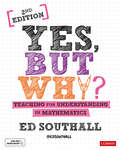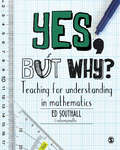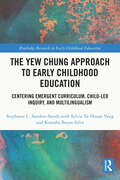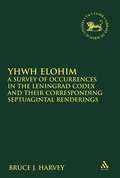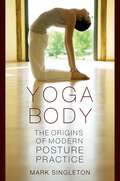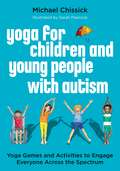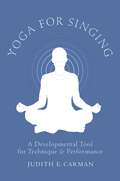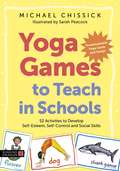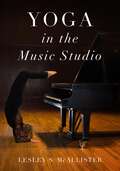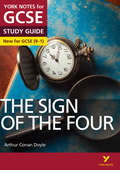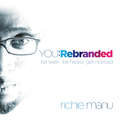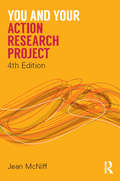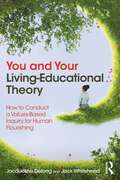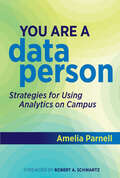- Table View
- List View
Yes, but why? Teaching for understanding in mathematics (Corwin Ltd)
by Ed SouthallGetting the right answers in maths is only half the problem. Understanding why what you’re doing works is the part that often stumps students and teachers alike. The essential guide for mathematics teachers and those training to teach, Yes, but why? answers all your questions, and sheds light on the hidden connections between everything in mathematics at school. This second edition includes: · A new ‘Test yourself’ feature in every chapter · More coverage of the four operations · Enhanced discussion of fractions and proportionality · Downloadable figures for use in the classroom
Yes, but why? Teaching for understanding in mathematics (Corwin Ltd)
by Ed SouthallGetting the right answers in maths is only half the problem. Understanding why what you’re doing works is the part that often stumps students and teachers alike. The essential guide for mathematics teachers and those training to teach, Yes, but why? answers all your questions, and sheds light on the hidden connections between everything in mathematics at school. This second edition includes: · A new ‘Test yourself’ feature in every chapter · More coverage of the four operations · Enhanced discussion of fractions and proportionality · Downloadable figures for use in the classroom
Yes, but why? Teaching for understanding in mathematics (Corwin Ltd)
by Ed SouthallGetting the right answers in maths is only half the problem. Understanding why what you’re doing works is the part that often stumps students and teachers alike. The essential guide for mathematics teachers and those training to teach, Yes, but why? answers all your questions, and sheds light on the hidden connections between everything in mathematics at school. This second edition includes: · A new ‘Test yourself’ feature in every chapter · More coverage of the four operations · Enhanced discussion of fractions and proportionality · Downloadable figures for use in the classroom
Yes, But Why? Teaching for Understanding in Mathematics (1st edition)
by Ed SouthallGetting the right answers in maths is only half the problem. Understanding why what you’re doing works is the part that often stumps students and teachers alike. Does maths feels like a collection of random rules and steps that somehow lead you to an answer? Don’t worry you’re not alone. Ask yourself: why do we have odd and even numbers? Why do two negative numbers multiply to make a positive? Why do fraction operations work? What is cosine and where does it come from? Yes, but why? answers all of your questions, and sheds light on the hidden connections between everything in mathematics at school. Maths makes sense. It always has, but until now maybe no-one ever showed you. A must-read for those training to teach primary or secondary mathematics via university-based (PGCE, BEd, BA w/QTS) or school-based (School Direct, SCITT, Teach First) routes and current teachers wishing to deepen their mathematical understanding.
Yes, But Why? Teaching for Understanding in Mathematics (1st edition) (PDF)
by Ed SouthallGetting the right answers in maths is only half the problem. Understanding why what you’re doing works is the part that often stumps students and teachers alike. Does maths feels like a collection of random rules and steps that somehow lead you to an answer? Don’t worry you’re not alone. Ask yourself: why do we have odd and even numbers? Why do two negative numbers multiply to make a positive? Why do fraction operations work? What is cosine and where does it come from? Yes, but why? answers all of your questions, and sheds light on the hidden connections between everything in mathematics at school. Maths makes sense. It always has, but until now maybe no-one ever showed you. A must-read for those training to teach primary or secondary mathematics via university-based (PGCE, BEd, BA w/QTS) or school-based (School Direct, SCITT, Teach First) routes and current teachers wishing to deepen their mathematical understanding.
The Yew Chung Approach to Early Childhood Education: Centering Emergent Curriculum, Child-Led Inquiry, and Multilingualism (Routledge Research in Early Childhood Education)
by Stephanie C. Sanders-Smith Sylvia Ya-Hsuan Yang Kutasha Bryan-SilvaThis volume details the Yew Chung Approach and the Twelve Values that exemplify the approach as a unique contribution to the field of early childhood education. The Yew Chung Education Foundation (YCEF) in Hong Kong is a nonprofit organization and a high-quality early childhood program that promotes a global lens and multilingualism through an emergent curriculum. This book explores the Twelve Values that exemplify the approach, including relationships, the emergent curriculum, inquiry-based pedagogy, and the multilingual and multicultural approach. Grounding these values in daily classroom practice and the broader sociocultural context of Hong Kong, it shows how the Yew Chung Approach effectively supports additional language learning through a progressive emergent curriculum with a high degree of child agency. It also explores the unique history of Hong Kong as an incubator and setting for the Yew Chung Approach and considers the relationships between the colonial history of the city, Hong Kong’s current status as a global city, and the mission of Yew Chung to provide children with a global lens. An important study which exemplifies and investigates a unique program and perspective within the field, this book will benefit scholarly and practitioner audiences within the global early childhood community, as well as appealing to academics, researchers and postgraduates working within early childhood education, comparative education, and bilingual education.
The Yew Chung Approach to Early Childhood Education: Centering Emergent Curriculum, Child-Led Inquiry, and Multilingualism (Routledge Research in Early Childhood Education)
by Stephanie C. Sanders-Smith Sylvia Ya-Hsuan Yang Kutasha Bryan-SilvaThis volume details the Yew Chung Approach and the Twelve Values that exemplify the approach as a unique contribution to the field of early childhood education. The Yew Chung Education Foundation (YCEF) in Hong Kong is a nonprofit organization and a high-quality early childhood program that promotes a global lens and multilingualism through an emergent curriculum. This book explores the Twelve Values that exemplify the approach, including relationships, the emergent curriculum, inquiry-based pedagogy, and the multilingual and multicultural approach. Grounding these values in daily classroom practice and the broader sociocultural context of Hong Kong, it shows how the Yew Chung Approach effectively supports additional language learning through a progressive emergent curriculum with a high degree of child agency. It also explores the unique history of Hong Kong as an incubator and setting for the Yew Chung Approach and considers the relationships between the colonial history of the city, Hong Kong’s current status as a global city, and the mission of Yew Chung to provide children with a global lens. An important study which exemplifies and investigates a unique program and perspective within the field, this book will benefit scholarly and practitioner audiences within the global early childhood community, as well as appealing to academics, researchers and postgraduates working within early childhood education, comparative education, and bilingual education.
YHWH Elohim: A Survey of Occurrences in the Leningrad Codex and their Corresponding Septuagintal Renderings (The Library of Hebrew Bible/Old Testament Studies)
by Bruce J. HarveyThis study provides a survey of all occurrences of YHWH that are followed by an Elohim appositive in the Leningrad Codex and their corresponding Septuagintal renderings. Its primary purpose is to demonstrate how each occurrence of YHWH Elohim, where Elohim is undetermined, could have resulted from changes made to an earlier text. It begins with a discussion of methodological issues. This is followed by a description of the Hebrew context of the 887 occurrences of YHWH Elohim in the Leningrad Codex. In addition to breakdowns according to book, syntactic function and speaker, a summary of corresponding variants in synoptic parallels, the Samaritan Pentateuch, Dead Sea Scrolls and mediaeval manuscripts is also provided. This is followed by a summary of corresponding Septuagintal renderings. These context descriptions provide the foundation for an analysis of the 38 occurrences of YHWH Elohim where Elohim is undetermined. Since four of these occurrences are followed by Sabaoth, a survey of all compound designations containing Sabaoth as well as an analysis of the 18 occurrences of YHWH Elohe Sabaoth are also provided.
Yoga Body: The Origins of Modern Posture Practice
by Mark SingletonYoga is so prevalent in the modern world--practiced by pop stars, taught in schools, and offered in yoga centers, health clubs, and even shopping malls--that we take its presence, and its meaning, for granted. But how did the current yoga boom happen? And is it really rooted in ancient Indian practices, as many of its adherents claim? In this groundbreaking book, Mark Singleton calls into question many commonly held beliefs about the nature and origins of postural yoga (asana) and suggests a radically new way of understanding the meaning of yoga as it is practiced by millions of people across the world today. Singleton shows that, contrary to popular belief, there is no evidence in the Indian tradition for the kind of health and fitness-oriented asana practice that dominates the global yoga scene of the twenty-first century. Singleton's surprising--and surely controversial--thesis is that yoga as it is popularly practiced today owes a greater debt to modern Indian nationalism and, even more surprisingly, to the spiritual aspirations of European bodybuilding and early 20th-century women's gymnastic movements of Europe and America, than it does to any ancient Indian yoga tradition. This discovery enables Singleton to explain, as no one has done before, how the most prevalent forms of postural yoga, like Ashtanga, Bikram and "Hatha" yoga, came to be the hugely popular phenomena they are today. Drawing on a wealth of rare documents from archives in India, the UK and the USA, as well as interviews with the few remaining, now very elderly figures in the 1930s Mysore asana revival, Yoga Body turns the conventional wisdom about yoga on its head.
Yoga Body: The Origins of Modern Posture Practice
by Mark SingletonYoga is so prevalent in the modern world--practiced by pop stars, taught in schools, and offered in yoga centers, health clubs, and even shopping malls--that we take its presence, and its meaning, for granted. But how did the current yoga boom happen? And is it really rooted in ancient Indian practices, as many of its adherents claim? In this groundbreaking book, Mark Singleton calls into question many commonly held beliefs about the nature and origins of postural yoga (asana) and suggests a radically new way of understanding the meaning of yoga as it is practiced by millions of people across the world today. Singleton shows that, contrary to popular belief, there is no evidence in the Indian tradition for the kind of health and fitness-oriented asana practice that dominates the global yoga scene of the twenty-first century. Singleton's surprising--and surely controversial--thesis is that yoga as it is popularly practiced today owes a greater debt to modern Indian nationalism and, even more surprisingly, to the spiritual aspirations of European bodybuilding and early 20th-century women's gymnastic movements of Europe and America, than it does to any ancient Indian yoga tradition. This discovery enables Singleton to explain, as no one has done before, how the most prevalent forms of postural yoga, like Ashtanga, Bikram and "Hatha" yoga, came to be the hugely popular phenomena they are today. Drawing on a wealth of rare documents from archives in India, the UK and the USA, as well as interviews with the few remaining, now very elderly figures in the 1930s Mysore asana revival, Yoga Body turns the conventional wisdom about yoga on its head.
Yoga for Children and Young People with Autism: Yoga Games and Activities to Engage Everyone Across the Spectrum
by Michael ChissickSpeaking from decades of experience, Michael Chissick shares the secrets to teaching yoga to children and young people with Autistic Spectrum Disorder (ASD).The physical, emotional and social benefits of yoga for autistic children can be profound, and this book will give you the confidence to get going with an array of fun activities and games from 'chasing the frog' to 'yoga detective'. Whether you work in special needs school, primary mainstream school or the community, or you are the parent of an autistic child, this book will equip you with plans, structures, goals, teaching tips and a multitude of real-life stories.The book is suitable for teaching everyone on the spectrum, with an emphasis on teaching those with more complicated needs. It is also relevant for use with children who have related needs such as ADHD and sensory processing challenges. Beautifully illustrated with images of the postures taught within, it is the perfect go-to resource for anyone interested in engaging children and young people in yoga.I can be a banana, can you?Suitable for ages 4-11
Yoga for Children with Autism Spectrum Disorders: A Step-by-Step Guide for Parents and Caregivers
by Dion Betts Stacey W. BettsThis illustrated book combines the authors' professional expertise with their experience of parenting, offering a range of gentle and fun yoga positions and breathing techniques that are effective in dealing with the increased levels of anxiety, disorientation and tactile sensitivity often found in children with autism spectrum disorders (ASDs).
Yoga for Singing: A Developmental Tool for Technique and Performance
by Judith E. CarmanThe 19th-century Italian singing teacher Giovanni Battista Lamperti once wrote, "'Know thyself' applies to the singer more than to other professions, because to sing well, body, soul, and mind are tuned together." Yoga, with its focus on connecting mind, body, and soul, is a tool that can greatly enhance the art of singing in this very way. In Yoga for Singing, author Judith Carman outlines the many connections between the two arts, presenting a systematic approach to yoga practices to support the development of singing technique as well as to lay a foundation for confident performance and a long and healthy singing career. She demonstrates how closely practices such as physical postures, breathing practices, and deep relaxation techniques match the needs of singers. Included in the book and its extensive companion website are copious illustrations and specific exercises designed to be used by singers and voice teachers, regardless of their level of experience with yoga. With a unique take on technique and performance improvement, this book is an excellent resource for both vocal students and professionals at any stage of their career.
Yoga for Singing: A Developmental Tool for Technique and Performance
by Judith E. CarmanThe 19th-century Italian singing teacher Giovanni Battista Lamperti once wrote, "'Know thyself' applies to the singer more than to other professions, because to sing well, body, soul, and mind are tuned together." Yoga, with its focus on connecting mind, body, and soul, is a tool that can greatly enhance the art of singing in this very way. In Yoga for Singing, author Judith Carman outlines the many connections between the two arts, presenting a systematic approach to yoga practices to support the development of singing technique as well as to lay a foundation for confident performance and a long and healthy singing career. She demonstrates how closely practices such as physical postures, breathing practices, and deep relaxation techniques match the needs of singers. Included in the book and its extensive companion website are copious illustrations and specific exercises designed to be used by singers and voice teachers, regardless of their level of experience with yoga. With a unique take on technique and performance improvement, this book is an excellent resource for both vocal students and professionals at any stage of their career.
Yoga Games to Teach in Schools: 52 Activities to Develop Self-Esteem, Self-Control and Social Skills
by Michael ChissickThe best way to teach yoga to children is with games. With 52 vibrant, easy-to-follow yoga games requiring no previous yoga experience, this book will enable you to help children become better listeners, take responsibility, gain self-control, improve behaviour, become assertive and improve self-esteem and confidence.Within these pages Michael Chissick has distilled nearly twenty years' experience of teaching yoga to children aged 3-11 in mainstream and special needs schools. He explains the ideal yoga lesson structure to transform your children's behaviour: you will learn which games to teach, when to teach them and how to teach them, and how the additional benefits of improved co-ordination, flexibility, fitness, self-calming and relaxation can be accessible to all children regardless of impairment, need, culture, shape, mood or size.
Yoga Girls' Club: Do Yoga, Make Art, Be You (PDF)
by Tiffani BryantYoga Girls' Club is a non-judgemental and fun environment for self-exploration where girls and young women can feel empowered to manage the changes, challenges and social pressures of teen life with confidence and self-awareness. The interactive workbook format introduces girls to yoga and meditation and offers frequent opportunities for self-reflection through short drawing and writing exercises, enabling girls to explore who they are and what they believe, in a positive and affirming way. The book guides the reader through 43 illustrated, easy-to-follow yoga postures, each with unique benefits for health and wellbeing, as well as explaining different yogic breathing techniques and suggesting yoga sequences to help girls develop their own yoga routines. There are also 9 fun art activities designed to encourage creative expression. Ideal for tween and teen girls aged 11-17, this book will also provide practical tools for yoga instructors, school counsellors, psychotherapists, arts therapists and youthworkers wanting to explore identity, encourage body confidence and promote self-esteem with this age group.
Yoga in the Music Studio
by Lesley S. McAllisterYoga in the Music Studio brings the popular and beneficial practice of yoga to music teachers and students of all instruments and ages, from preschoolers to senior adults and all those in-between. Expert on mind-body techniques Lesley S. McAllister provides a unique opportunity for all to improve their musical craft, enabling teachers to help their students concentrate, listen more attentively, relax, and play their best - whether before a performance or just during lessons - all through the practice of yoga. Many music teachers know that yoga postures and breathing practices can help musicians achieve peak performance, prevent injury, and relieve pain, yet surprisingly few are themselves familiar with these techniques or know how to introduce them to their students. McAllister welcomes the music teacher into the philosophy and history of yoga, introducing them to the research behind yoga's physical and emotional benefits. Step-by-step illustrations of practical stretches and useful poses then guide the teacher to the yoga practices that suit their individual needs and those of their students. An accessible and comprehensive yoga curriculum, Yoga in the Music Studio will help to improve students' musicianship, while contributing to their lifelong health and wellness.
YOGA IN THE MUSIC STUDIO C
by Lesley S. McAllisterYoga in the Music Studio brings the popular and beneficial practice of yoga to music teachers and students of all instruments and ages, from preschoolers to senior adults and all those in-between. Expert on mind-body techniques Lesley S. McAllister provides a unique opportunity for all to improve their musical craft, enabling teachers to help their students concentrate, listen more attentively, relax, and play their best - whether before a performance or just during lessons - all through the practice of yoga. Many music teachers know that yoga postures and breathing practices can help musicians achieve peak performance, prevent injury, and relieve pain, yet surprisingly few are themselves familiar with these techniques or know how to introduce them to their students. McAllister welcomes the music teacher into the philosophy and history of yoga, introducing them to the research behind yoga's physical and emotional benefits. Step-by-step illustrations of practical stretches and useful poses then guide the teacher to the yoga practices that suit their individual needs and those of their students. An accessible and comprehensive yoga curriculum, Yoga in the Music Studio will help to improve students' musicianship, while contributing to their lifelong health and wellness.
York Notes for GCSE (9-1), Study Guide: The Sign of the Four
by Ms Jo HeathcoteA fully revised exam section: expert guidance on understanding the question, planning an answer, writing about effects and using quotations, plus tips on spelling, punctuation and grammar. All the key skills covered: ‘Exam focus’ model answer extracts with annotations, and ‘Progress and Revision Checks’ will guide your learning, help you test your progress and reach your potential. The most in-depth analysis: from text summaries to characters, themes, contexts, form, structure and language, all designed to help you to succeed.
You: Be seen, be heard, get noticed
by Richie ManuThis book will inspire and enthuse you and change the way you think about yourself and your career. You: Rebranded delivers a distinct, provocative and abstract perspective in a compelling practical guide, with indispensable creative elements to improve your career prospects, opportunities and networks, whether you are at the start of your career or finding new paths and direction in your current career. It also serves as a sign post to other essential material, with links and pointers to unique interviews, stories, anecdotes and references. It also puts the reader in full control with digestible, and manageable, tasks and actions which have proven results. Key subjects and features include: •Know your Industry: Know yourself •Building and nurturing important relationships •Key interviews and perspectives •New mode of engagement for 21st Century thinking •Differentiating Yourself •Breaking career myths and misconceptions •Vocabulary, codes and clues •Wellbeing •Manageable Actions and Tasks putting you in control
You and Your Action Research Project
by Jean McNiffYou and Your Action Research Project is packed full of useful advice to take the reader through the various stages of an action research project. Written for practitioners across professions who are studying on work-based learning programmes and award-bearing courses, this book contains practical strategies for improving project work. Split into the following five sections; Thinking about doing a project, Getting ready to do a project, Planning a project and managing it, Doing your project, Evaluating your action research project, the structure is clearly accessible and easy-to-read, encouraging readers of cross-curricular interests from teachers, to nurses and social workers to try new approaches. This fourth edition of the best-seller has been thoroughly updated and improved, with new and up-to-date case study material from a very wide range of disciplines, greater emphasis on the need for dialogical practices, points for reflection, more developed ideas about sorting and analysing data, and a stronger focus on writing as a form of research. With key sections on engaging with the literatures and collaborative practices, whilst also developing ideas about writing and data analysis, this book will be essential reading for those wanting to begin and further develop their action research. Jean McNiff is an independent researcher and writer, Professor of Educational Research at York St John University, and Adjunct Professor at the University of Limerick. She is also the author of key text Action Research: Principles and Practice.
You and Your Action Research Project
by Jean McNiffYou and Your Action Research Project is packed full of useful advice to take the reader through the various stages of an action research project. Written for practitioners across professions who are studying on work-based learning programmes and award-bearing courses, this book contains practical strategies for improving project work. Split into the following five sections; Thinking about doing a project, Getting ready to do a project, Planning a project and managing it, Doing your project, Evaluating your action research project, the structure is clearly accessible and easy-to-read, encouraging readers of cross-curricular interests from teachers, to nurses and social workers to try new approaches. This fourth edition of the best-seller has been thoroughly updated and improved, with new and up-to-date case study material from a very wide range of disciplines, greater emphasis on the need for dialogical practices, points for reflection, more developed ideas about sorting and analysing data, and a stronger focus on writing as a form of research. With key sections on engaging with the literatures and collaborative practices, whilst also developing ideas about writing and data analysis, this book will be essential reading for those wanting to begin and further develop their action research. Jean McNiff is an independent researcher and writer, Professor of Educational Research at York St John University, and Adjunct Professor at the University of Limerick. She is also the author of key text Action Research: Principles and Practice.
You and Your Living-Educational Theory: How to Conduct a Values-Based Inquiry for Human Flourishing
by Jacqueline Delong Jack WhiteheadThrough the narratives of practitioner-researchers, this practical guide shares the proven processes, phases and supports that are most effective for generating living-educational-theories with values of human flourishing. Filled with case studies and continuing professional development activities, this book supports readers to conduct a values-based inquiry to improve their lives, describing and explaining how they influence themselves, others and the places where they live and work. There are four parts to the book, guiding readers through the process of creating and sharing their own living-educational-theory: Part One is designed to meet the needs of the beginning researcher as they start a project to improve their practice. Part Two builds on Part One to address the deeper, more complex requirements of those interested in more academic projects potentially for accreditation at the Master’s level. Part Three is a description and explanation of the history and context of Living Educational Theory Research with a focus on doctoral degrees. Part Four focuses on applying this knowledge more widely to living our educational responsibilities as global citizens. This book will serve as a useful guide, as opposed to a fixed template, to support readers in living their values more fully. It is an essential resource for all practitioners interested in establishing a Culture of Inquiry to create their own living-educational-theories. These are explanations of values-based professional development within their school community and can be submitted for academic accreditation.
You and Your Living-Educational Theory: How to Conduct a Values-Based Inquiry for Human Flourishing
by Jacqueline Delong Jack WhiteheadThrough the narratives of practitioner-researchers, this practical guide shares the proven processes, phases and supports that are most effective for generating living-educational-theories with values of human flourishing. Filled with case studies and continuing professional development activities, this book supports readers to conduct a values-based inquiry to improve their lives, describing and explaining how they influence themselves, others and the places where they live and work. There are four parts to the book, guiding readers through the process of creating and sharing their own living-educational-theory: Part One is designed to meet the needs of the beginning researcher as they start a project to improve their practice. Part Two builds on Part One to address the deeper, more complex requirements of those interested in more academic projects potentially for accreditation at the Master’s level. Part Three is a description and explanation of the history and context of Living Educational Theory Research with a focus on doctoral degrees. Part Four focuses on applying this knowledge more widely to living our educational responsibilities as global citizens. This book will serve as a useful guide, as opposed to a fixed template, to support readers in living their values more fully. It is an essential resource for all practitioners interested in establishing a Culture of Inquiry to create their own living-educational-theories. These are explanations of values-based professional development within their school community and can be submitted for academic accreditation.
You Are a Data Person: Strategies for Using Analytics on Campus
by Amelia ParnellInternal and external pressure continues to mount for college professionals to provide evidence of successful activities, programs, and services, which means that, going forward, nearly every campus professional will need to approach their work with a data-informed perspective.But you find yourself thinking “I am not a data person”.Yes, you are. Or can be with the help of Amelia Parnell.You Are a Data Person provides context for the levels at which you are currently comfortable using data, helps you identify both the areas where you should strengthen your knowledge and where you can use this knowledge in your particular university role.For example, the rising cost to deliver high-quality programs and services to students has pushed many institutions to reallocate resources to find efficiencies. Also, more institutions are intentionally connecting classroom and cocurricular learning experiences which, in some instances, requires an increased gathering of evidence that students have acquired certain skills and competencies. In addition to programs, services, and pedagogy, professionals are constantly monitoring the rates at which students are entering, remaining enrolled in, and leaving the institution, as those movements impact the institution’s financial position.From teaching professors to student affairs personnel and beyond, Parnell offers tangible examples of how professionals can make data contributions at their current and future knowledge level, and will even inspire readers to take the initiative to engage in data projects.The book includes a set of self-assessment questions and a companion set of action steps and available resources to help readers accept their identity as a data person. It also includes an annotated list of at least 20 indicators that any higher education professional can examine without sophisticated data analyses.
